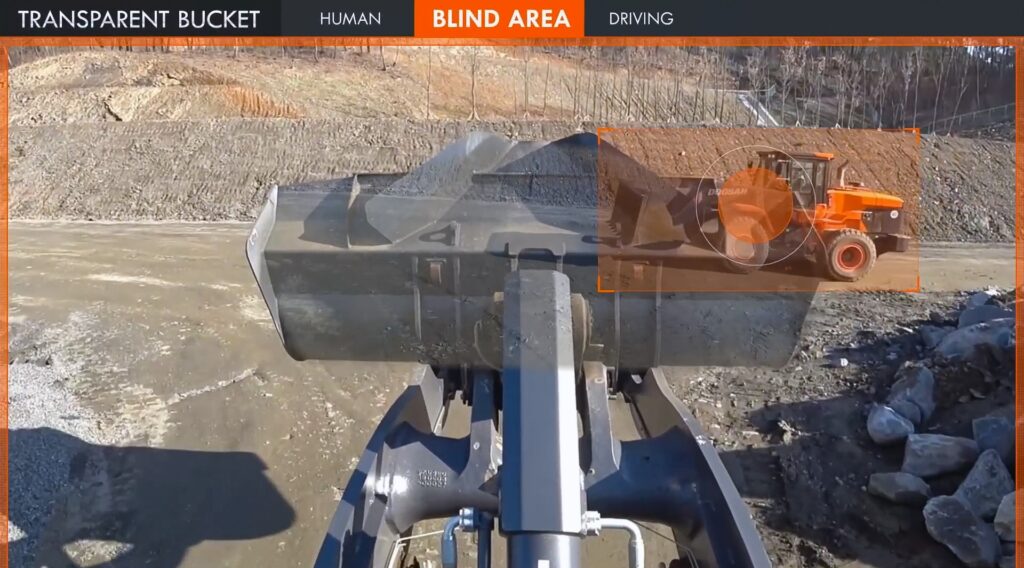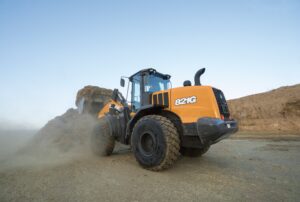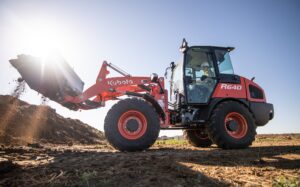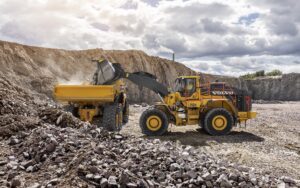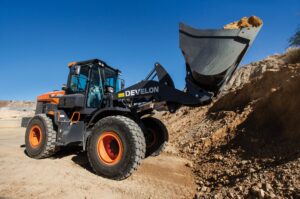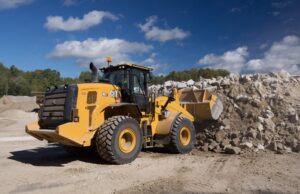
Advanced wheel loader technologies
By NATE HENDLEY
Construction Equipment Equipment TechnologyFrom transparent buckets to electric prototypes, manufacturers are stepping up the segment.
Improved visibility, via “transparent” buckets and other means, operator comfort, and sustainability are all trending on the wheel loader front. Of these developments, sustainability is attracting particular notice.
“If you look at the sustainability side, everybody’s trying to figure out what direction to go, what to use to help their fuel savings … You’ll see people looking at different types of transmissions that will give you better fuel consumptions, so there are a lot of ways to chase it,” says Neil Detra, product manager for wheel loaders and compact wheel loaders at Case Construction Equipment.
“Everybody wants to reduce their carbon footprint,” agrees Eric Yeomans, product manager for wheel loaders at Volvo Construction Equipment.
In Volvo’s homeland of Sweden, HVO or “Hydrotreated Vegetable Oil” (oil derived from fats and vegetables) is sometimes used to power vehicles, says Yeomans. Plantbased bio-fuel is also a niche fossil fuel alternative in North America.
While other alternatives such as hydrogen remain largely conceptual for the time being, electric wheel loaders are now a reality. Electric prototypes have been introduced and R&D is ongoing. Some high hurdles remain, however, before electric wheel loaders become commonplace on construction sites.
“I think we’re all probably struggling with [the idea that] you have an electric vehicle—how do you take care of that on-site? How do you charge it? Because if you’re on a remote site and don’t have voltage, how do you do it? Do you buy a diesel generator? That’s not a solution—because the purpose of buying the electric vehicle was to [eliminate using fossil fuels]. So charging is the big issue,” says Yeomans.
For all that, Yeomans, like other industry experts, remains enthusiastic about wheel loader developments.
“I’ve been with Volvo since 1977. For me it’s really exciting to see how we transitioned from … basically diesel engines and a manual gearbox, to now where we have electric-drive machines,” he states.
With that, here’s a look at what’s new and/or noteworthy in wheel loaders.
CASE
Case introduced several enhancements on its G Series wheel loaders in 2021, with an emphasis on cab upgrades. The upgrades were done to benefit operators and make it easier for them to run the machine, says Detra.
Upgrades included a new touchscreen display, and an optional payload system for more precise loading. The payload system, integrated into the primary display in the cab, provides data about bucket weight, accumulated/running weight, job tracking, and pass counts. A trio of colour-coded, configurable buttons located on the right armrest, meanwhile, allow operators to pre-program certain settings to make their work more efficient.
The G Series also features a Tire Pressure Monitoring System (TPMS). Sensors mounted to tire valve stems transit information to a receiver module which forwards this data to the display unit in the cab. The operator is alerted when tire pressure is too low or high, averting wear and tear or a possible blowout.
“You can set the tire pressure range, because on wheel loaders it varies depending on tire sizes and whether [the tires are] radial or bias. You set the range and then the system monitors it,” explains Detra.
SiteWatch telematics, which is standard on the G Series, has been augmented with a new SiteConnect Module for improved data collection and analysis. Using a SiteManager App, this data can be remotely monitored on a phone or laptop.
G Series wheel loaders have been approved to use B20 bio-diesel fuel by Fiat Powertrain Technologies (FTP) Industrial, an Italian manufacturer with a focus on eco-friendly engines.
KUBOTA
Kubota’s R540 and R640, offer an array of safety and productivity-enhancing features. The R540 has a 54-horsepower Tier 4 Final engine, an operating weight of 10,285 lb., and a ground-level lifting capacity of 6,767 lb. The R640 has a 64-horsepower Tier 4 Final engine, an operating weight of 11,563 lb. and ground-level lifting capacity of 8,161 lb.
Both models feature KubotaNow, the company’s telematics system, which provides operators and owners with realtime performance data, machine diagnostics, fault codes, location information, etc. Operators can also use KubotaNow to create a geofence—a digital perimeter around the wheel loader’s designated work area. Should the wheel loader leave this zone, an alert is issued.
KubotaNow can also detect unusual activity. For example, if your loader were “being transported on a truck, it will give you a message like ‘machine being transported,’” says Jonathan Gardner, product manager, construction equipment, at Kubota Canada.
If theft is suspected, additional security measures can be taken. “You can remotely shut [the machine] off, so the next time they try to start it, it won’t start,” explains Gardner.
The R540 and R640 also feature a bigger front window, a simplified interior layout compared to previous models, an all-glass right-side window for better visibility, standard LED work lights, and a reconfigured right-hand side console for the operator’s ease-of-use.
The wheel loader arms have also been redesigned to further enhance visibility and attachments can be connected without the operator leaving the cab.
Kubota also changed the vent placement in the R540 and R640 to maximize cool air flow in summer and defrost capabilities in winter, which is an important consideration in Canada.
VOLVO
Volvo continues to be a leader when it comes to electrification and high-tech enhancements. Volvo wheel loaders now feature a digital solution called Connected Load Out, designed to improve productivity and efficiency during the load out process while reducing fuel consumption and CO2 emissions. The system links the wheel loader, trucks being loaded, and the site office. Orders and load tickets are digitized and shared within this network.
Volvo wheel loaders have also been fitted with a pioneering Collision Mitigation System featuring an automatic braking function. If a wheel loader is traveling in reverse and the system senses that it is about to hit an object, “the machine will [automatically] brake” for a few seconds, alerting the operator of the danger, explains Yeomans.
Other Volvo innovations include the L120H Electric Conversion wheel loader. This is an electrified version of the L120 wheel loader. The converted L120H electric wheel loader offers the same performance as the diesel version, but with zero exhaust emission and minimal noise. This machine is being tried out in Europe and isn’t available in North America yet, says Yeomans.
Volvo also recently updated the L350H wheel loader, with a view to increasing productivity and lowering fuel consumption. Weighing 56 tonnes, the L350H2, as Volvo calls it, has new axles, a new drivetrain, and a new Opti-Shift transmission (offering smoother shifting, with an automatic lock-up feature in second, third, and fourth gear, ensuring better fuel efficiency).
Load-sensing technology monitors hydraulic pressure and flow in the L350H2 and makes adjustments based on load requirements, increasing efficiency, and lowering energy use.
DEVELON
“In our nomenclature, the dash seven [-7] represents the latest and greatest product that we’re offering,” says Jacob Sherman, Product and Dealer Marketing Manager at Develon.
The models have a standard, industry- exclusive “transparent” bucket, which Sherman describes as the pinnacle in a series of cutting-edge safety and efficiency features on these machines. To clarify, the bucket isn’t made out of see-through material. Rather, a camera set-up relays images of what’s in front of the bucket to a monitor in the cab. This clever system “eliminates a lot of the blind spot” that occurs when lifting or moving buckets, notes Sherman.
Other notable safety and efficiency features include greater bucket capacity than previous models, three engine power modes (power, normal and economy), a Smart Load system to weigh material in the bucket, updated heavy-duty axles, dynamic braking, and a standard rear-view camera.
Operator comfort has not been ignored either: the dash seven cab is spacious, with an air suspension seat, and an interior that is conveniently laid-out, says Sherman.
CATERPILLAR
Caterpillar’s new 950 and 962 medium- wheel loaders are the company’s latest Next Generation wheel loaders. The 950 weighs 19,260 kg (42,461 lb.) while the 962 comes in at 20,171 kg (44,469 lb.). Both machines have a Cat C7.1 engine and a bucket capacity range of 2.67 to 9.90 cubic metres (3.5 to 13 cubic yards).
Compared to earlier series, “we are offering basically 30 per cent lower maintenance costs,” says Scott Schmidtgall, product applications specialist for medium wheel loaders at Caterpillar. The 950 and 962 have a seat-mounted electro-hydraulic joystick steering for improved visibility, maneuverability, and operator comfort. These models also feature Cat Payload as a standard feature, which displays real-time bucket payload weight data to prevent over or underloading.
The company says several standard ease of use, assist and payload features help boost productivity up by up to 10 per cent over previous loaders. Beyond productivity, Autodig as well as Auto Set Tires, both part of the Assist feature suite, facilitate proper loading while reducing tire slippage and wear and tear.
A rear-vision camera and floor-to-ceiling cab windshield is standard in both models. A 360-degree multiview vision system is optional, as is Cat Detect, “a radar-based object detection system for when that operator is backing up,” says Schmidtgall.
The 950 and 962 also feature adjustable seats, extra legroom in the cab, a four-point harness kit, and ProductLink, which connects the wheel loader to the office and tracks production data and machine diagnostics.
Nate Hendley is a freelance writer and author, and is a regular contributor to On-Site Magazine.

